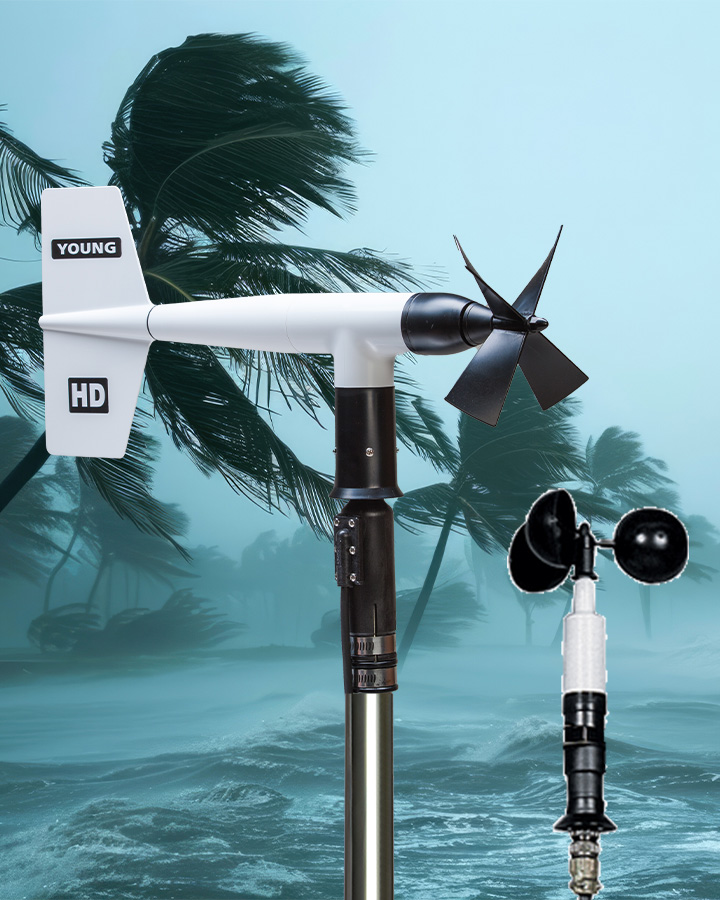When it comes to measuring wind accurately and reliably, the choice of sensor matters. While 3-cup anemometers have long been a staple in meteorological instrumentation, they’re no longer the best option for many modern applications. At R.M. Young Company, we believe the Wind Monitor represents a significant advancement in wind measurement technology. Here’s why.
1. Engineered for Extreme Conditions
One of the most compelling reasons to choose the R.M. Young Wind Monitor is its rugged construction and ability to operate in extreme environments. Designed to accurately measure wind speeds up to 100 m/s (over 220 mph), it far exceeds the capability of most 3-cup anemometers, which typically max out around 60 m/s. In applications such as hurricane monitoring, aviation, offshore platforms, and high-altitude research, durability and high-speed performance are non-negotiable. The Wind Monitor delivers on both.
2. Precision You Can Rely On
Accuracy is everything when it comes to environmental data, and the Wind Monitor offers superior performance in this area. Its propeller and vane design ensures lower error margins across a wide range of speeds and directions. Traditional 3-cup anemometers tend to become less accurate at higher wind speeds and in rapidly changing conditions. For researchers and professionals who depend on precise readings, the Wind Monitor provides a reliable edge.
3. Rapid Response to Changing Conditions
Wind doesn’t always behave in a steady or predictable manner. That’s why dynamic response time is critical. The Wind Monitor is specifically designed to respond quickly to changes in both wind speed and direction. Its balanced propeller system enables it to react more swiftly than 3-cup models, which often lag in capturing rapid fluctuations. This makes the Wind Monitor particularly well-suited for meteorological research, turbulence studies, and any scenario where wind behavior needs to be tracked in real time.
4. Finer Wind Speed Resolution
Resolution—the ability to detect small variations in wind speed—can be just as important as overall accuracy. The RM Young Wind Monitor provides finer resolution than many traditional 3-cup anemometers, allowing it to capture more subtle changes in wind conditions. This enhanced sensitivity is especially valuable in applications where small shifts in wind speed can have a significant impact.
5. More Accurate Response to Off-Axis Wind
In environments where wind can come from unpredictable angles—like mountainous regions, urban landscapes, or around large structures—3-cup anemometers often over-report wind speed due to off-axis wind. The Wind Monitor’s design allows it to more accurately reflect true wind conditions regardless of the wind’s approach angle, providing data you can trust even in turbulent airflow.
6. Unaffected by Air Density Changes
Another key advantage of the Wind Monitor is its immunity to changes in air density. Because its measurement principle doesn’t rely on air mass, it’s unaffected by shifts in air pressure or temperature. This means you get consistent, reliable readings whether you’re monitoring conditions in a tropical rainforest, a desert plateau, or a high-altitude mountaintop. In contrast, 3-cup anemometers can show inconsistent results as environmental conditions vary.
Conclusion: The Clear Choice for Professionals
The Wind Monitor is not just an upgrade—it’s a leap forward in wind measurement. From its high-speed durability and precise accuracy to its superior response and resolution, it outperforms traditional 3-cup anemometers in virtually every category. Whether you’re outfitting a mesonet, designing a custom weather station, or working in extreme field conditions, the R.M. Young Wind Monitor is built to meet the demands of modern meteorology.
If you’d like more information about the Wind Monitor or want help determining which model is right for your application, feel free to reach out. We’re here to help you measure the world more precisely.


